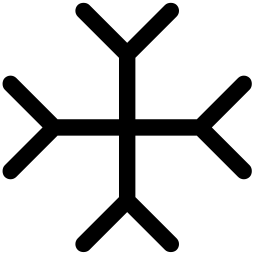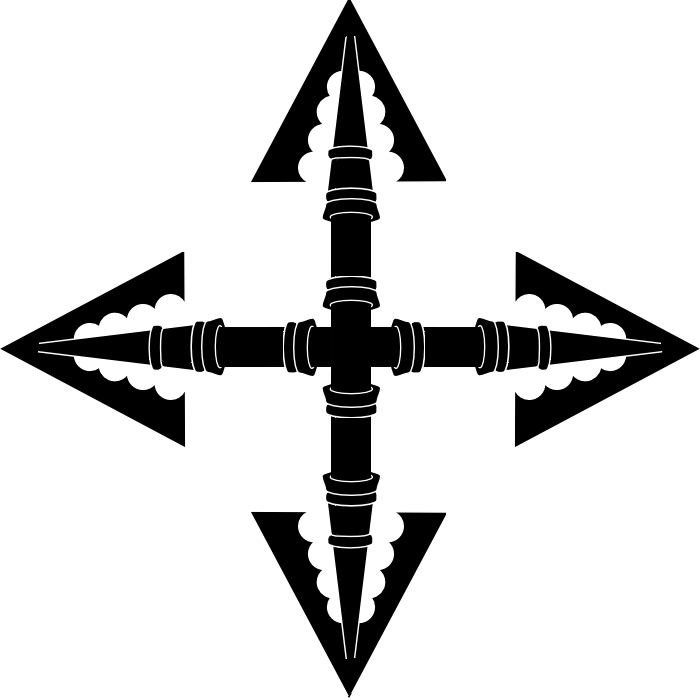Barbee Cross
Also known as croix tournee or croix cramponnée, Crosstar. Pheon Cross or Arrow Cross
A simple design with various uses and meanings, depending the situation: geographical, spiritual, social, ideological, racial or even sexual!




Arrow heads may be 'V' shaped or triangular, and may point inwards or outwards. The third image (above) is of the Barbie Cross on the flag of Horni Mostenice, Czech Republic. The fourth image is seen on the flag of Cajetina, Serbia.
Similar to the arrow head is the pheon which has engrailed blades. Pheon crosses. with inner- or outer-pointing blades, are less common:
In French heraldic terms, the Cross Barbee is known as Croix Tournée ('turn', as in a spiked turnpike) or Croix Cramponnée (crampon, as in hook, grappling iron, or the hooked attachment at the end of a scaling ladder). The same name is also applied to some Anchor Crosses. If the inner edges of an arrow head are jagged then its heraldic name is a pheon.
Another English word for 'barb' is 'hook', and true to the rebus nature of heraldry, the Barbee Cross is named after its shape.
As a cross, the barbs are fish-hooks or fishing spears, and a reminder of Jesus' words "Follow me, and I will make you fishers of men." The missionary's task is to spread the Christian message to the four corners of the world, and this cross also reminds us of the compass, with its arrows pointing north, south, east and west. (See also Cardinal Cross)
There are several variations; single- or double-sided, but they all mimic a barb of some kind. The single-sided Barbee Cross (the upper image shown above on the left) is similar but unrelated to the Ninja Star and Swastika. The Ninja Star and Swastika symbolize rotation, advancing forward like a propeller screw. In contrast, the Barbee Cross symbolizes holding steady, as with an anchor.
The arrow-head shape also gives the name Arrow Cross, which is favoured by White supremacists who see their goal moving in all directions. This symbol, from the centuries-old Árpád striped banners, was used by the 1930s Hungarian Arrow Cross Party, a fascist group modelled on the German Nazi party, who force-marched 80,000 Jews to the Austrian border and from there to Auschwitz. Although that party has been disbanded, this symbol (which they call Crosstar) is still popular with other racist, anti-Semitic and anti-communist groups in the USA. One reason is because of its simple symmetry, like the swastika. (See also the Swedish Yellow Cross.)
Much earlier, the arrow was used to symbolise the plague (see Plague Cross) of which the Italian San Sebastian is a patron saint. He is also the patron saint of Rio de Janeiro. In Christian art, the arrow suggests a spiritual weapon. Saint Sebastian is often depicted with his body bound to a pillar and pierced by arrows; an ordeal which he survived.
More recent is the corporate logo of the EV company Charge Cars. We'll probably see much more of their logo as the business grows.
Pheon Cross
On the less-common Pheon Cross, the arms may be long or short. For each arrow head, the distinguishing feature is the blade's engrailed inner edges. It is incorporated in a few heraldic coats of arms, mainly English.
The arrow head shown on the left was used by the Office of Ordnance created by Henry VIII in 1544 and became a common mark on crown property.
The etymology of pheon, and why this symbol was chosen, are unknown but the east-facing Norman 'Broad Arrow Tower', one of 13 defensive towers around the Tower of London, was built by Henry III some time between 1238 and 1272 to house part of the garrison. They presumably carried lances with the broad arrow pattern.
Gold stars (like Baptismal Crosses) appear on the walls of the 1st floor chamber of the Broad Arrow Tower.
This room was occupied by Sir Simon Burley, tutor to Richard II, who took refuge in the Tower during the Peasant's Revolt of 1381.
With a painting on the door of St. Peter holding a key (see Keys of Heaven), the gold stars on the blue walls appear to represent heaven. But rather than the familiar triangular wedges usually used for stars, these might have been deliberately fashioned to represent Pheon Crosses.
In 1698 it became illegal to mark anything with the symbol which was not government property, and it is still an offence today. The mark was ubiquitous in the two World Wars and appeared on ordnance and military equipment, although not on war-related civilian ID cards or food ration cards.
Large broad arrows were printed on British prison uniforms from the 1870s. Not surprisingly, convicts throughout Britain and its colonies felt uncomfortable at being branded 'Government Property' and the fashion was officially retired in 1922. (Some older prisons in Britain still have a few old pieces of equipment in use bearing this mark.)
Perhaps because of the symbol's dark image and the restriction on its use since 1698, the Pheon Cross is rarely seen.
So much for Italians, Brazilians, Hungarians, Americans, Swedes and French. For us Australians, the barbie is a way of life!

Barbie Cross
See also the Broad Arrow Cross, Anchor Cross and the Fusilly Cross
Incidentally, and somewhat confusingly, the English word 'barb' comes from the Latin 'barba', which means 'beard'. From this we get the word 'barber'.
Another homonym is 'barbarian', which is from the Greek 'barbaros', meaning 'foreign person'.
Luke 5:2-10
Today's Magyar Garda, the uniformed section of the far-right wing of Jobbik (Movement for a Better Hungary), currently wears similarly distinctive badges on their black paramilitary-style uniforms
Photo from amazon.com/... (1990) published by New Amsterdam Books ISBN-10: 1871569214 ISBN-13: 978-1871569216. James Bartholomew






